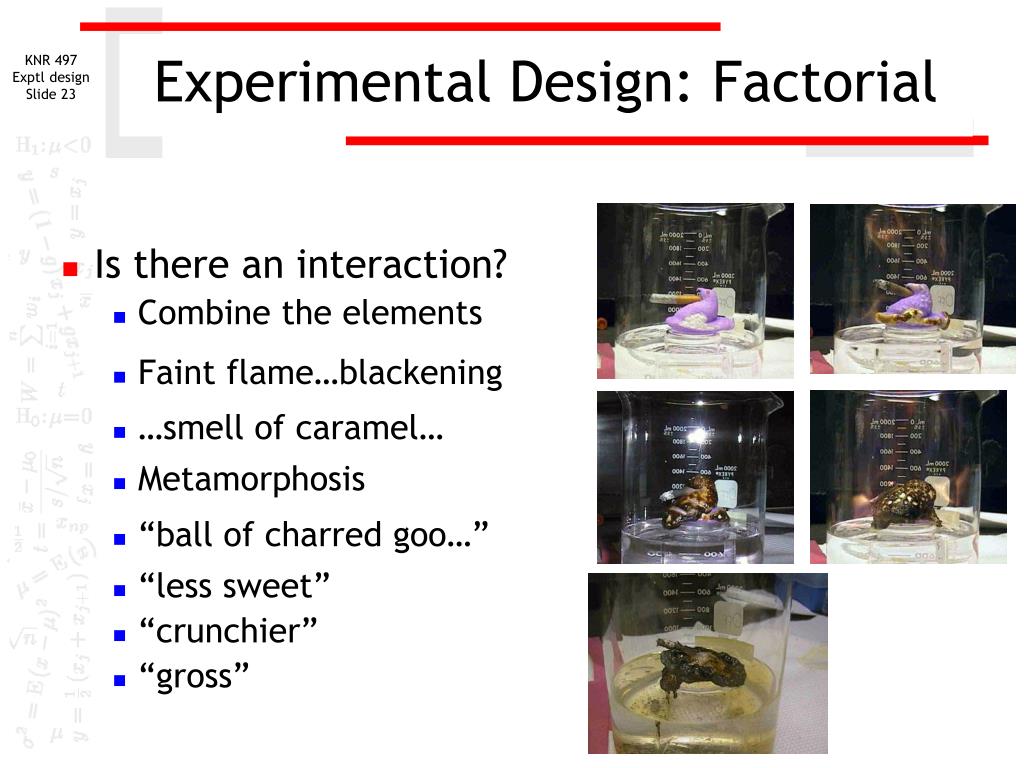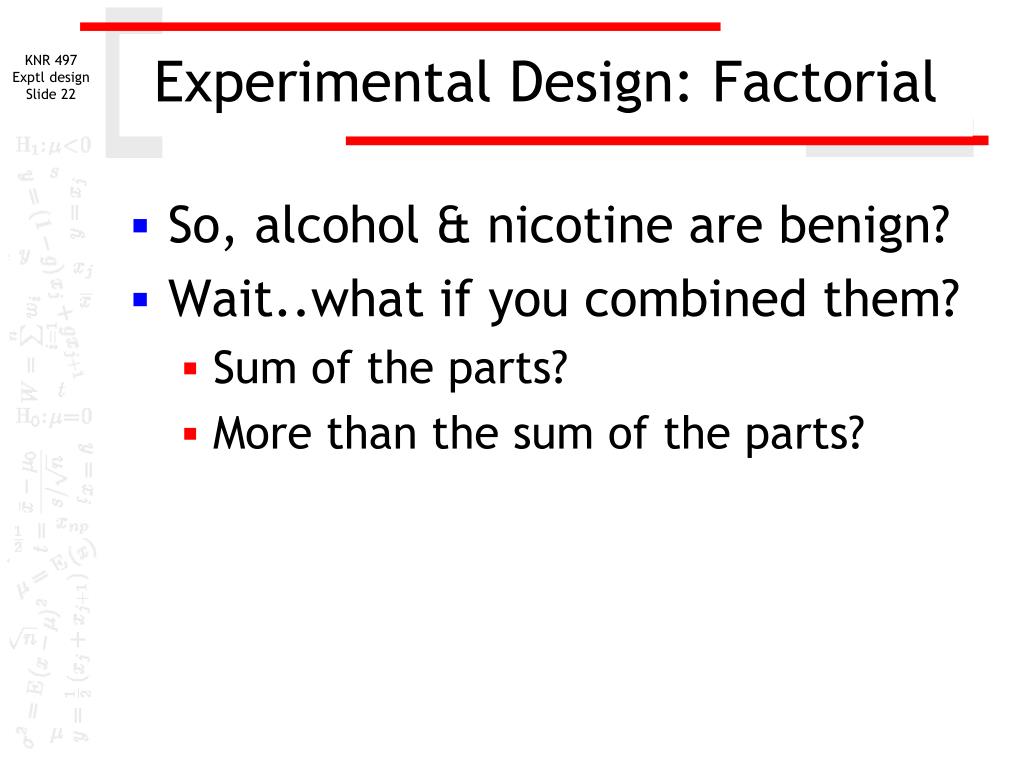Table Of Content

For most scenarios, however, near-optimal designs are adequate and not hard to obtain. Simultaneous examination of multiple factors at two levels can reveal which have an effect. Factorial designs are the basis for another important principle besides blocking - examining several factors simultaneously. We will start by looking at just two factors and then generalize to more than two factors. Investigating multiple factors in the same design automatically gives us replication for each of the factors. As seen above, RPM is shown with a positive effect for number of theoretical stages, but a negative effect for wt% methanol in biodiesel.
1 Setting Up a Factorial Experiment
A positive effect means that as RPM increases, the number of theoretical stages increases. Whereas a negative effect indicates that as RPM increases, the wt% methanol in biodiesel decreases. When choosing operating conditions for the POD, RPM should be maximized to minimize the residual methanol in biodiesel and maximize the number of theoretical stages achieved.
Optimal experimental design for precise parameter estimation in competitive cross-reaction equilibria
If the research questions call for direct comparison of individual experimental conditions, as is required when treatment packages are being compared, then this design will usually be an RCT. If the research questions call for assessing the effects of individual components of an intervention, then this design will usually be a factorial experiment. Thus, investigators must decide if they wish to directly compare two treatment conditions (and these may be multicomponential) with one another, without the results being affected by the presence of other experimental factors being manipulated.

Factorial Design Example
In the figure, the area selected in black is where the responses will be inputted. For instance, if the purity, yield, and residual amount of catalyst was measured in the DOE study, the values of these for each trial would be entered in the columns. The default factors are named "A", "B", "C", and "D" and have respective high and low levels of 1 and -1. The name of the factors can be changed by simply clicking in the box and typing a new name. Additionally, the low and high levels for each factor can be modified in this menu. Since the high and low levels for each factor may not be known when the design is first created, it is convenient to be able to define them later.
Mechanical optimization of virgin and recycled poly(ethylene terephthalate) biocomposites with sustainable biocarbon ... - ScienceDirect.com
Mechanical optimization of virgin and recycled poly(ethylene terephthalate) biocomposites with sustainable biocarbon ....
Posted: Thu, 23 Jan 2020 15:20:07 GMT [source]
What is a Factorial Experiment?
These runs are chosen carefully so that under the reasonable assumptions of effect sparsity and hierarchy, the terms of interest (e.g., main effects and two-factor interactions) can be estimated. Once the factorial effects have been computed, the natural question is whether they are large enough to be of statistical and scientific interest. Thus, if all factorial terms are included in the model, traditional regression-based inferences cannot be made because there is no estimate of residual error. In a three-factor experiment, this issue can be addressed by replication, but for larger studies this might be infeasible owing to the large number of treatments. Alternatively, an investigator might modify an intervention when it co-occurs with a particular, second intervention component. For instance, assume that a design has three factors; two are medication factors (e.g., varenicline, on/off, in one factor and NRT product [nicotine patch vs. nicotine lozenge], in a second factor).
How to Analyze a 2×2 Factorial Design
Design development of sustainable brick-waste geopolymer brick using full factorial design methodology - ScienceDirect.com
Design development of sustainable brick-waste geopolymer brick using full factorial design methodology.
Posted: Fri, 17 Mar 2023 07:00:00 GMT [source]
In the main "Create Factorial Design" menu, click "OK" once all specifications are complete. The following table is obtained for a 2-level, 4 factor, full factorial design. None of the levels were specified as they appear as -1 and 1 for low and high levels, respectively. Although the full factorial provides better resolution and is a more complete analysis, the 1/2 fraction requires half the number of runs as the full factorial design. In lack of time or to get a general idea of the relationships, the 1/2 fraction design is a good choice.
While more research on IC interactions is surely needed, our research has consistently found such interactions (Cook et al., 2016; Fraser et al., 2014; Piper et al., 2016; Schlam et al., 2016). Thus, it might be difficult in many cases to assume conditions that would justify the use of a fractional factorial design. If one of the independent variables had a third level (e.g., using a handheld cell phone, using a hands-free cell phone, and not using a cell phone), then it would be a 3 × 2 factorial design, and there would be six distinct conditions. Notice that the number of possible conditions is the product of the numbers of levels. A 2 × 2 factorial design has four conditions, a 3 × 2 factorial design has six conditions, a 4 × 5 factorial design would have 20 conditions, and so on.

Since we have two factors, each of which has two levels, we say that we have a 2 x 2 or a 22 factorial design. Typically, when performing factorial design, there will be two levels, and n different factors. Because factorial design can lead to a large number of trials, which can become expensive and time-consuming, factorial design is best used for a small number of variables with few states (1 to 3). Factorial design works well when interactions between variables are strong and important and where every variable contributes significantly. Again, because neither independent variable in this example was manipulated, it is a non-experimental study rather than an experiment. Again, because neither independent variable in this example was manipulated, it is a cross-sectional study rather than an experiment.
2: Design of experiments via factorial designs
The Pareto charts are bar charts which allow users to easily see which factors have significant effects. Analysis was performed on the DOE study to determine the effects of each factor on the responses. Only first order terms were included in the analysis to create a linear model. Pareto charts for both wt% MeOH in biodiesel and number of theoretical stages are shown below. Because experiments from the POD are time consuming, a half fraction design of 8 trial was used. Factors A - D can be renamed to represent the actual factors of the system.
In essence, if it is necessary to follow-up an interaction by identifying which particular subgroups differ from one another, some of the efficiency of the factorial design may be lost. However, it is important to note that interaction effects can be highly informative without simple effects tests (Baker et al., 2016; Box et al., 2005). The choice of control conditions can also affect burden and complexity for both staff and patients.
This is what was seen graphically, since the graph with dosage on the horizontal axis has a slope with larger magnitude than the graph with age on the horizontal axis. In the previous section, we looked at a qualitative approach to determining the effects of different factors using factorial design. Now we are going to shift gears and look at factorial design in a quantitative approach in order to determine how much influence the factors in an experiment have on the outcome. Experiments that include more than one independent variable in which each level of one independent variable is combined with each level of the others to produce all possible combinations.
For example, people are either low in hypochondriasis or high in hypochondriasis; they cannot be tested in both of these conditions. Second, such studies are generally considered to be experiments as long as at least one independent variable is manipulated, regardless of how many non-manipulated independent variables are included. Third, it is important to remember that causal conclusions can only be drawn about the manipulated independent variable. For example, Schnall and her colleagues were justified in concluding that disgust affected the harshness of their participants’ moral judgments because they manipulated that variable and randomly assigned participants to the clean or messy room. But they would not have been justified in concluding that participants’ private body consciousness affected the harshness of their participants’ moral judgments because they did not manipulate that variable. It could be, for example, that having a strict moral code and a heightened awareness of one’s body are both caused by some third variable (e.g., neuroticism).
The Main Total Effect can be related to input variables by moving along the row and looking at the first column. To get a mean factorial effect, the totals needs to be divided by 2 times the number of replicates, where a replicate is a repeated experiment. When there is a large interaction, main effects have little practical meaning as a significant interaction often masks the significance of main effects. The last four column vectors belong to the A × B interaction, as their entries depend on the values of both factors, and as all four columns are orthogonal to the columns for A and B. Time series analysis is used to analyze data collected over time in order to identify trends, patterns, or changes in the data.
Often, coding the levels as (1) low/high, (2) -/+, (3) -1/+1, or (4) 0/1 is more convenient and meaningful than the actual level of the factors, especially for the designs and analyses of the factorial experiments. These coding systems are particularly useful in developing the methods in factorial and fractional factorial design of experiments. Moreover, general formula and methods can only be developed utilizing the coding system. Often, coded levels produce smooth, meaningful and easy to understand contour plots and response surfaces.
If no adherence main effect is found, is that because this component was inconsistently delivered (adjusted for each medication)? In sum, investigators should be cognizant of the possible effects of such intervention adjustment and consider options for addressing them (e.g., by making only essential adjustments to a component, nesting an adjusted factor in the design). It has been argued that factorial designs epitomize the true beginning of modern behavioral research and have caused a significant paradigm shift in the way social scientists conceptualize their research questions and produce objective outcomes (Kerlinger & Lee, 2000). Factorial design can be categorized as an experimental methodology which goes beyond common single-variable experimentation. In the past, social scientists had been transfixed on singular independent variable experiments and foreshadowed the importance of extraneous variables which are able to attenuate or diminish research findings. With widespread adoption of factorial design, social scientists could now...

No comments:
Post a Comment